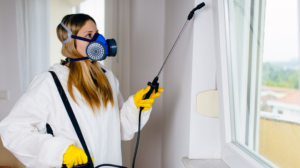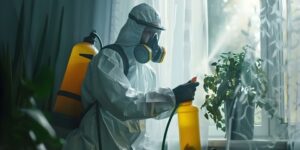Pest Control In Bakersfield is the action to reduce undesirable creatures that interfere with our activities. This can include physical controls such as traps and baits.
Some natural forces influence pest populations, such as climate and water availability. Natural barriers such as mountains and large bodies of water restrict the movement of many pests.

Pest infestations can pose a health and safety risk to homes and businesses. Prevention is the first step in controlling unwanted pests, and it involves identifying and denying them access to food, water, and shelter. Infestations are caused by a variety of factors, including biological contamination (rodent droppings or urine), physical contamination (fleas, flies, and fermentation flies), chemical contamination (spores, fungi, and intestinal parasites), and direct damage to property (carpenter ants, termites, wood-destroying beetles).
Preventing pest infestations can be achieved through cleanliness, hygiene practices, and regular maintenance and inspections. Clutter and overgrowth provide hiding places for pests, so be sure to regularly clean living or working areas. Also, store food in airtight containers and dispose of garbage regularly to reduce attracting pests. Leaky pipes and standing water can also be a source of water for some pests, so make sure to fix leaky faucets and maintain proper drainage.
Cracks and gaps in foundations, walls, and windows can allow pests to enter a building. Seal these entry points with caulk and weatherstripping. Also, keep trees and shrubbery away from the walls of buildings, as they can serve as bridges for pests.
Pests are attracted to a home or business because of its food and water sources, as well as its warmth and shelter. Infestations can result in contamination of food, destruction of product and packaging, direct damage to property, and health hazards for the residents or employees of a facility.
There are several steps you can take to prevent pests from infiltrating your home or business. The best way to prevent an infestation is by denying them food, water, and shelter. Food sources can be limited by keeping kitchens and pantry areas clean, storing food in airtight containers, and avoiding over-spending on groceries. Stacks of newspapers and cardboard are perfect hiding spots for rodents, so be sure to recycle these materials. Other food sources can be denied by having designated garbage bins for recyclables and general trash, rinsing out waste containers before discarding them, and not leaving food scraps out overnight. Finally, a good pest control program should include the use of pesticides. However, you should choose a pesticide carefully and follow its instructions. Some pesticides, such as baits, are more effective and less toxic than others, such as sprays.
Suppression
Pests can pose a health risk and cause damage to buildings, equipment and food in residential and commercial environments. They are typically attracted to areas where they can find food, water and shelter, leading to contamination with disease causing agents, physical damage to products and packaging, and direct damage to structures such as roofs or electrical wiring.
The most common types of pests are rodents, cockroaches, beetles, ants, termites and bed bugs. Prevention is the best strategy to prevent infestations. This includes thoroughly inspecting the property for cracks and holes, identifying and removing food and water sources, and reducing places where pests can hide. Regular cleaning and disposal of waste, especially in outdoor containers, can also help control pest populations.
Chemical controls are often used to control pests. These can include traps, barriers, sprays, fumigants and other devices. Chemicals should only be used as directed, and only after a thorough inspection and evaluation of their effect on the environment and people.
Some pests are so damaging that they must be controlled. The goal should be to do this while causing as little harm to other organisms, the environment and human society as possible. This means avoiding unnecessary use of pesticides and using them only when the benefits outweigh the costs.
Insecticides are generally the most effective chemical pest control products. In addition to their toxic effects on pests, they can also have adverse impacts on the environment and people, particularly when the product is used incorrectly or in excessive quantities.
Other methods can be used to control pests, including physical and mechanical control. This can include traps, screens, fences and other devices, and adjusting the environment to limit food and water supplies, or to make it unattractive for pests. For example, keeping food in airtight containers or storing trash in outside dumpsters can eliminate an ant problem and reduce the attraction of garbage for rodents. Similarly, maintaining climate conditions recommended for the preservation of books and papers (temperature, relative humidity, light and air quality) can control insect infestations.
Biological pest control is the most environmentally friendly approach to controlling pests, and it can be quite effective as well. Biological methods utilize non-toxic organisms that can prevent or eliminate pests, including predators, parasites and pathogens. These organisms typically require a host for survival and may take some time to work.
Eradication
Eradicating pests requires a careful balance between protecting human health and the preservation of natural habitat. This is especially important when dealing with pests that are important for regulating ecosystems, such as predatory birds and bats. For this reason, pest control often involves removing or managing populations rather than killing them outright.
Pesticides are a common method of pest control, but they’re not the only option. There are also a number of non-toxic alternatives, such as heat treatment and oxygen deprivation. Many of these methods can be used in conjunction with each other to achieve effective results.
Steps to prevent infestations include reducing food sources, eliminating moisture and sealing pest entry points. Pests often enter buildings through small cracks and crevices. Sealing them can help eliminate pests such as rats, mice and cockroaches. It can also eliminate other threats, such as carpenter ants and termites that are attracted to wet wood.
Another key step is to be vigilant and recognize warning signs of pests. Pests usually leave droppings or other clues, such as gnawed furniture or discarded wings. Clutter and disorganization can hide warning signs, so cleaning regularly can reduce the likelihood of a pest problem. For example, if you see a rat dropping in your attic, that’s a good sign that there’s a problem and you should take action right away.
While eradication is sometimes necessary, it’s always best to prevent an infestation in the first place. The simplest way to do this is by maintaining proper cleanliness, including cleaning kitchen surfaces daily and keeping garbage containers tightly closed. It’s also essential to keep exterior spaces clean. This can prevent pests from seeking shelter inside, as well as preventing them from accessing areas where they could cause damage or spread disease.
For commercial facilities, it’s a good idea to close and seal any pest-sized gaps, such as holes in the walls, floor or roof, and to install screens on windows. It’s also important to plant shrubbery and trees away from the building, and to remove vines and ivy that can climb on or hang over the side of a structure.
Biological Control
As an alternative to chemical pesticides, biological control utilizes predators, parasitoids, disease pathogens and competitors to suppress insect pest populations and damage. Unlike chemical pesticides, natural enemies do not harm ecosystems and can be used without fear of pest resistance. However, biological controls may take longer than conventional chemical controls to have an effect on a pest population, and they require careful monitoring and management.
In addition to introducing the biological control organism to a field, steps must be taken to ensure that the natural enemy survives and is effective in controlling the pest. This includes ensuring that the natural enemy is not susceptible to the same pesticides or toxins as the target pest and that it is available at the right time in the pest life cycle (egg, larval, adult).
The biology of natural enemies is complex and differs from pest species to species. In general, biological control organisms are characterized by high mortality rates, rapid reproduction, good searching ability and specificity to the host species. They are also dependent on favorable environmental conditions and the presence of other natural enemies. Moreover, they are susceptible to anthropogenic spreading and to conditions that encourage pest densities or habitats conducive to disease outbreaks.
Biological control is a desirable tactic because it is environmentally safe, energy self-sufficient, cost-effective and sustainable and can be easily integrated into an Integrated Pest Management (IPM) program. It is also a relatively low-impact strategy that minimizes the risk of pesticide resistance.
Biological control involves either the importation of exotic natural enemies for release and permanent establishment in a new region or the augmentation of resident or introduced natural enemies (usually through the use of microbial pesticides). The classical biological control method is more expensive than traditional chemical control but requires rigorous quarantine and testing procedures to determine the viability of new agents. The augmentation method, on the other hand, requires the development of mass rearing technologies for natural enemies that can be released in large numbers, which can reduce costs. Regardless of the approach, it will take six to ten generations or more before biological control brings pest numbers below the economic threshold.




